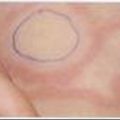8.4 Acute weakness
Presentation
Trauma masquerading as weakness
Trauma is dealt with in detail in other chapters of the book. However, it should noted that non-accidental injury (NAI) can present as ‘acute weakness’ in the infant and young child. Shaken baby syndrome may present as a lethargic irritable child with little or no bruising. The apparent focal weakness may be due to an underlying fracture. Likewise, emotional and nutritional neglect may also lead to weakness. Hence, NAI must be considered in the differential diagnosis of the acutely weak child (see Chapter 18.2).
Primary survey approach
ABC
The effects of weakness may include airway compromise from bulbar palsy (e.g. hoarse voice, stridor, and aspiration of secretions). Severely impaired ventilation will be clinically apparent. However, mild or moderate impairment can be subtle and can rapidly progress to cause respiratory embarrassment. Therefore, if possible, respiratory function tests should be serially performed on all children presenting with neuromuscular weakness. Arterial or venous blood gases should also be considered in this assessment. (Table 8.4.1 for predictors of needing intubation and mechanical ventilation.) Circulatory defects may arise from disturbance of the autonomic nervous system. This is characterised by labile blood pressure, heart rate and postural hypotension.
Examination
Investigations
Laboratory
Tests that may be useful in the acutely weak child include:
Specific conditions causing acute weakness
Guillain–Barré syndrome
Differential diagnosis
As laboratory tests may be normal in early GBS and signs may be variable, it is important to exclude other causes of acute weakness (Table 8.4.2).
Treatment
The main role of the emergency physician in the treatment of GBS is in monitoring, prevention and treatment of cardiovascular and respiratory complications. In addition to monitoring of vital signs and cardiac rhythm, frequent examinations and (if possible) lung function tests should be performed. As noted above, progression to respiratory failure can be surprisingly rapid and the indicators for intubation listed in Table 8.4.3 should be actively sought to avoid respiratory arrest. The other less emergent treatments of GBS are either intravenous immunoglobulin or plasma exchange. This is indicated if the child can not walk unaided, has bulbar palsy, has rapidly progressive weakness, or worsening respiratory status. The immunoglobulin dose is usually 2 g kg–1 given in divided doses with variable regimes.
Disposition
Children with suspected GBS should be admitted and closely observed for the evolution of severe weakness that can occur. The findings outlined in Table 8.4.1 will assist in deciding who should go to an intensive care unit (ICU)/high dependency unit and who should go to the general ward. Children with any one of these features should be monitored in a paediatric ICU.
Tick paralysis
Other envenomations
Snake and spider bites are discussed in detail elsewhere in the text (see Chapter 22.1). Usually the history and accompanying symptoms will give the diagnosis. Death adder envenomation is usually a purely neurological presentation so in the weak non-verbal child a thorough look for a bite site is indicated.
Botulism
Poisoning with botulinum toxin can present in three ways:
Infant botulism
Diagnosis of this condition is characterised by:
Spinal cord lesions
Myasthenia gravis (MG)
Congenital myasthenia
This is a lasting condition due to a genetic disorder. It is not due to antibodies to the AChR.
Toxic neuropathies
A long list of substances can cause acute weakness. Some of the more common ones are listed here.
Anticholinesterases
The organophosphates and carbamates are commonly used insecticides, which can cause poisoning through skin, oral or pulmonary exposure. They inhibit cholinesterases, allowing acetylcholine to persistently stimulate the nicotinic and muscarinic receptors, which then can become refractory and thus cause weakness. This weakness is usually accompanied by the cholinergic toxidrome (see Chapter 21.2 on toxicology) and, indeed, it is usually the respiratory and cardiac features that predominate. However, there is an intermediate syndrome where 12 hours to 7 days after the initial poisoning, one finds proximal limb weakness that is unresponsive to atropine or pralidoxime. There may also be respiratory and bulbar paralysis. Recovery from this is usually complete. Late neurotoxicity arises 4–21 days after the acute exposure, causing a mixed sensory motor deficit, which may take weeks or months to recover, or may be permanent. Diagnosis is by identification of the poison at source or in urine or serum drug screens and also by measuring serum cholinesterase activity level. Treatment is supportive and with antidotes atropine and pralidoxime. Muscle relaxants will have a prolonged effect and should be avoided if possible.
Behrman R.E., Kliegman R., Jenson H.B., editors. Nelson Textbook of Pediatrics, 16th ed., Philadelphia: WB Saunders, 2000.
Emilia-Romagna Study Group on Clinical and Epidemiological Problems in Neurology. Incidence of myasthenia gravis in the Emilia-Romagna region: A prospective multicenter study. Neurology. 1998;51(1):255-258. [brief communications]
Lawn N.D., Fletcher D.D., Henderson R.D., et al. Anticipating mechanical ventilation in Guillain–Barré syndrome. Arch Neurol. 2001;58:893-898.
Odaka M., Yuki N., Hirata K. Anti-GQ1b IgG antibody syndrome: Clinical and immunological range. J Neurol, Neurosurg Psychiatry. 2001;70:50-55.
Tang T., Noble-Jamieson C. A painful hip as a presentation of Guillain-Barré syndrome in children. Br Med J. 2001;322:149-150.










